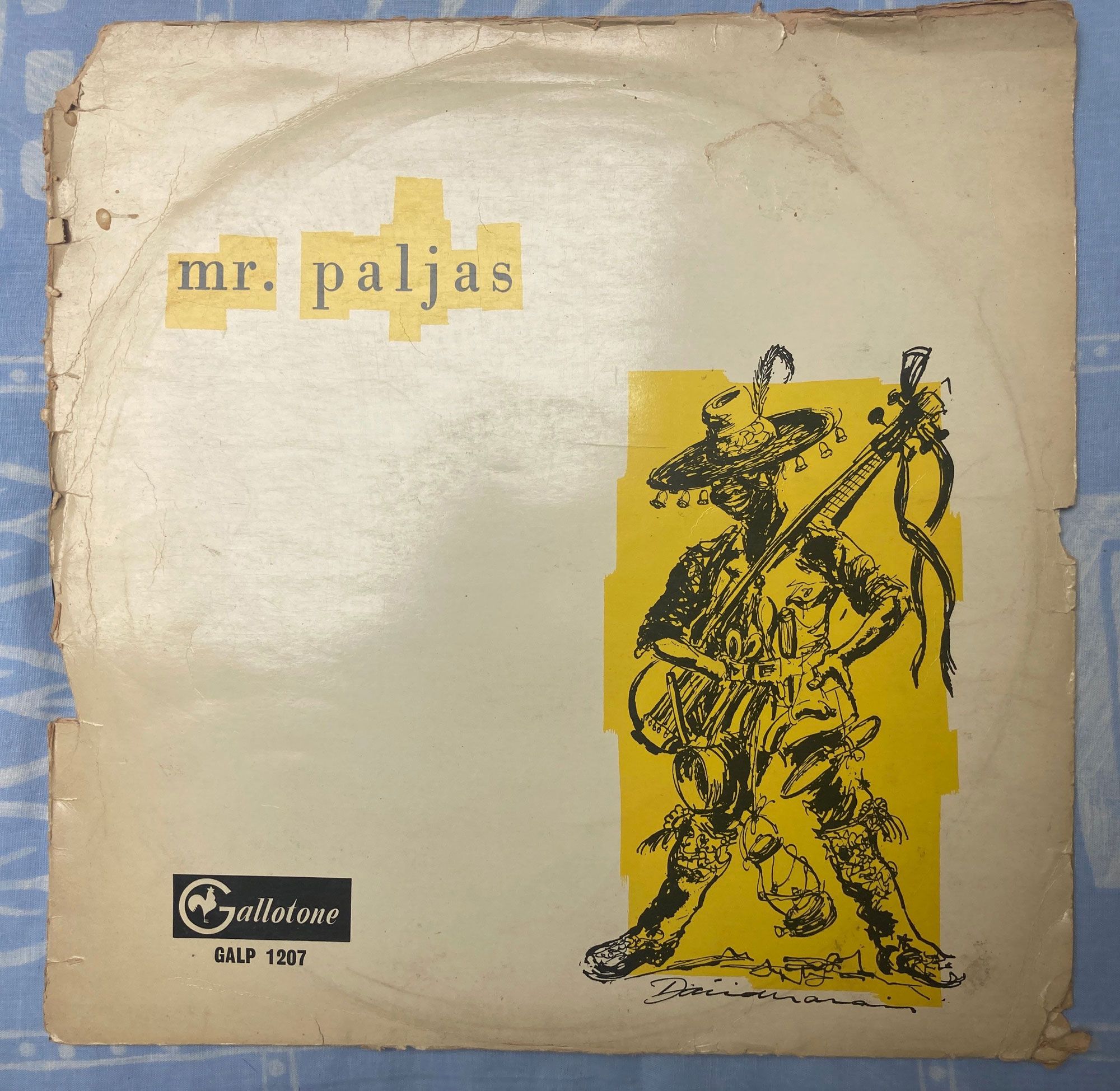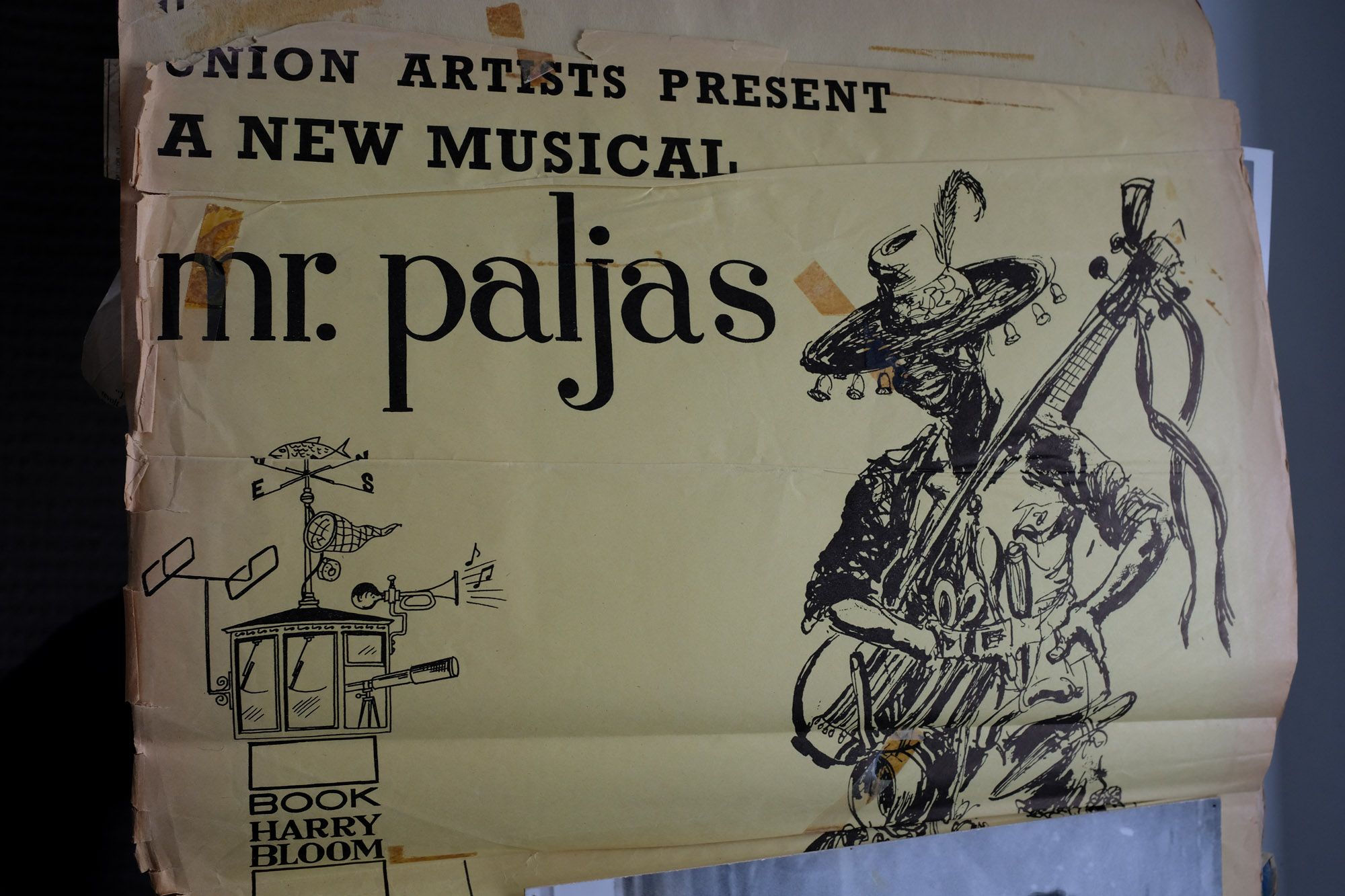ADAM GLASSER
In Search of Mr. Paljas
I first heard the words Mr. Paljas back in 1961. I was 6 years old. We lived in Laundry Cottage, Durban Rd just below the Wynberg Military Garrison. My father Stanley ‘Spike’ Glasser had recently returned from London after months conducting the King Kong band at the Princes Theatre in the West End.
A Saturday morning: Spike on the phone for hours on end in the hallway. The day wears on. I never imagined you could talk that long. The subject? Another musical.
In January of that year Chris Macgregor (then a composition student of Spike’s) had on my father’s request driven my mother, sister and me to Johannesburg where the King Kong cast had reassembled to rehearse for their trip to London. I remember the matinée at the Wits Great Hall, endless grey isle carpet, the knives tucked in boots for the Knife Dance. Days later standing on the balcony of Jan Smuts Airport waving the cast goodbye, my Dad amongst them. I was shocked to see so many adults towering above me weeping. All this fresh in my memory. Now talk of another musical. Would it take Dad away again? No – this show was to be in Cape Town. Something about fishermen and boats …. a magicial bergie – Mr. Paljas.

I am put in the back of our car with my younger sister the way kids were sommer taken along for convenience. Dad is driving fast to the Cape Town docks. On De Waal Drive a combi pulls in front and signals us to stop. Traffic cop emerges – kaks Dad out in Afrikaans for speeding. Spike always an expert at conciliation in such circumstances. No ticket, only a warning.
Research for Mr. Paljas: Small tin shed/warehouse by a quayside in the docks. Dad standing before a group of skeptical fishermen still in oilskins seated along the walls of the shed, invited at random off the trawlers moored nearby. ‘Now tell me this – what would you sing at work fishing for example? If you were at sea or hauling in nets on the beach at Muizenberg or Hout Bay?’ Half hearted raspy vocals, little appetite for song in response to this jolly enthusiam. I feel the uneasiness, awkward vibe in the room.
The orchestra pit at the Labia Theatre during a rehearsal: alone with a drum kit – sticks lying across the snare. No one around. I pick up a stick and hesitate a moment, crash it experimentally down on a cymbal. The unexpected noise deafens me. I freeze. Adult conversation nearby stops – sharp looks in my direction. A tall young man steps forward smiling, encourages me to have one more bash and then gently removes the sticks out of my reach – it was Chris MacGregor.

If you are looking to read here the definitive solid academic account of the musical Mr. Paljas you will be disappointed. It doesnt exist yet as far as I am aware. This story is pieced together from random sources, acquaintances’ memories, and my family archive. I wish I had started this 30 years ago and interviewed those involved.
If I have a story to tell beyond memory it is thanks to my late mother Mona De Beer (Glasser at the time) who with her Librarian/Archivist/Writer/Editor instincts kept the Paljas programme, a copy of the script, a now deleted Gallo LP and a folder of cuttings that she knew would be worth preserving for the future. Thanks also to my sister Sue Glasser

(seated on the railing of the Laundry Cottage photo) who developed her own version of our mother’s habit of meticulous preservation of anything that could possibly be of future narrative interest and importance.
Mona’s family photo archive contained a set of brilliant distinctive photos taken at a braaivleis in our back garden for members of the Paljas cast.
I always wondered about the identity of the photographer. But did not get the answer until earlier this year when visiting South African actor/writer/poet Ruth Rosen (née Abromowitz) – a friend of Mona’s from way back. Resident in London for many years Ruth was fully involved in Mr. Paljas as the Speech Coach. Photos and cuttings she shared at our meeting included fragments from a magazine article “Mr Paljas Cuts a Disc” – text by Yvonne Bryceland (later acclaimed for her role in Athol Fugard’s play Statements After an Arrest Under the Immorality Act) and photographs by Cloete Breytenbach.

You cannot tell which magazine it was because the title is cut off. Yet these photos provided stylistic certainty that the photographer at the cast braaivleis was Cloete Breytenbach (who I then noticed was credited with the band photograph on the back cover of the album).
Further confirmation came when google led me to herri #2 which features Cloete’s sublime photos of the Eoan group, all shots displaying the characteristic genius of his observational eye, sense of composition, distinctive textural delicacy creating sublime tones of light and shade. I was certain that there must be other cast braai photos I had not seen. The ones we had (which feature all the Glassers – Mona, Spike, Adam and Sue) were clearly only those given to the family. Surely there must have been many other photos taken that afternoon.
I wrote immediately to Aryan Kaganof. Where might I look for the missing Paljas cast braai photos? Aryan replied with an invitation to write this piece and put me in touch with Dr Hilde Roos (herri contributor and Acting Director of the Africa Open Institute for Music, Research and Innovation, Faculty of Arts and Social Sciences, Stellenbosch University). A correspondence with Santie De Jongh (Special Collections Librarian at the Stellenbosch University Music Library’s Documentionation Centre for Music (DOMUS) led to further cast photos from the show to which Cloete’s son Leon Breytenbach gave his blessing to be used for this article.

Leon confirmed that there is still a large trove of his father’s photos unsorted amongst which the cast braai photos might exist, yet to be discovered.
The flurry of correspondence early this year uncovered more photos of the Paljas production via the Eoan Group archive as well as piano parts and leadsheets of the original songs composed by Spike Glasser and lyrics by Beryl Bloom, wife of Harry Bloom, the author of the book, who had come up with the script and basic plot for Mr. Paljas.

The story was based on a magical figure – Paljas – who transforms the lives of a fictional Cape fishing community at the fictional location of Abrahams Bay. Produced by Ian Berhardt’s Union Artists (the multiracial production company behind the success of King Kong‘s nationwide tours and subsequent move to London’s West End) Mr. Paljas the musical opened on 12 January 1962 at the Labia Theatre in Cape Town. I know the exact date thanks to Steve Bloom the son of (Harry and Beryl) now a distinguished photographer based in England who has memories and a collection of scrapbooks and cuttings relating both to King Kong and Mr Paljas. My gratitude to Steve for sharing some of these with me earlier this year.
While Mr. Paljas brought together a talented ensemble of mainly Cape Town based artists, from children and first timers on stage to top contemporary jazz musicians and experienced members of the Eoan Group (as well as former King Kong cast members Thandie Klaasen, George Tau and Josh Makhene), the exclusively white creatives developed only a lightweight engagement with the community whose cultural identity they appropriated naively for the show – but creative bonds and personal relationships developed between members of the production from all backgrounds. One example of which was the romance between lead singer Maud Damons and Spike Glasser who were forced to flee the country in late 1962 after being charged under the Immorality Act.

The Paljas script reveals the artistic limitations of a plot and characters in which well meaning white creatives, embedded in apartheid South Africa caricature without awareness the lives of a Cape coloured fishing community to which they have little real connection.
But Spike Glasser’s lifelong love of township jazz caused him to make a brilliant call, giving a key musical role to one of his young composition students Chris Macgregor, an experienced jazz pianist fully active on the Cape Town scene. The future leader of the iconic Blue Notes as well as The Brotherhood of Breath was to have a massive influence on the show’s music, getting deeply involved in the arrangements and bringing into the pit band cutting edge musicians such as trumpeter Dennis Mphale and alto saxophonist Dudu Pukwana.


Spike’s songs and Beryl Bloom’s lyrics are in my ‘biased objective opinion’ strong compositions of considerable charm and quality on their own, but the legacy of Mr. Paljas the musical derives solely from sound track LP being repackaged and illegally distributed as a ‘Chris Macgregor and the Blue Notes’ type product. Listen to it any time on Apple Music or Spotify. The horn section and rhythm section pack the kind of punch only capable of being produced by great South African jazz musicians.
Chris du Toit as far back as 2009 wrote an honourable and well informed piece for that precious treasure trove of South African jazz and popular music which is Electric Jive Blogspot. Though you can listen to Mr. Paljas any time on Apple Music or Spotify thanks to Mr. Paljas being commercially released by ‘Black Cat Productions’ based in Skopje Macedonia. I’d like to know if they have done this legally or not.

CODA
‘In Search of Mr. Paljas’ is designed to connect up and put in touch any of the cast still around or members of their family and descendents. Please feel free to write to Adam Glasser harmonicastories@gmail.com The story is ongoing…



